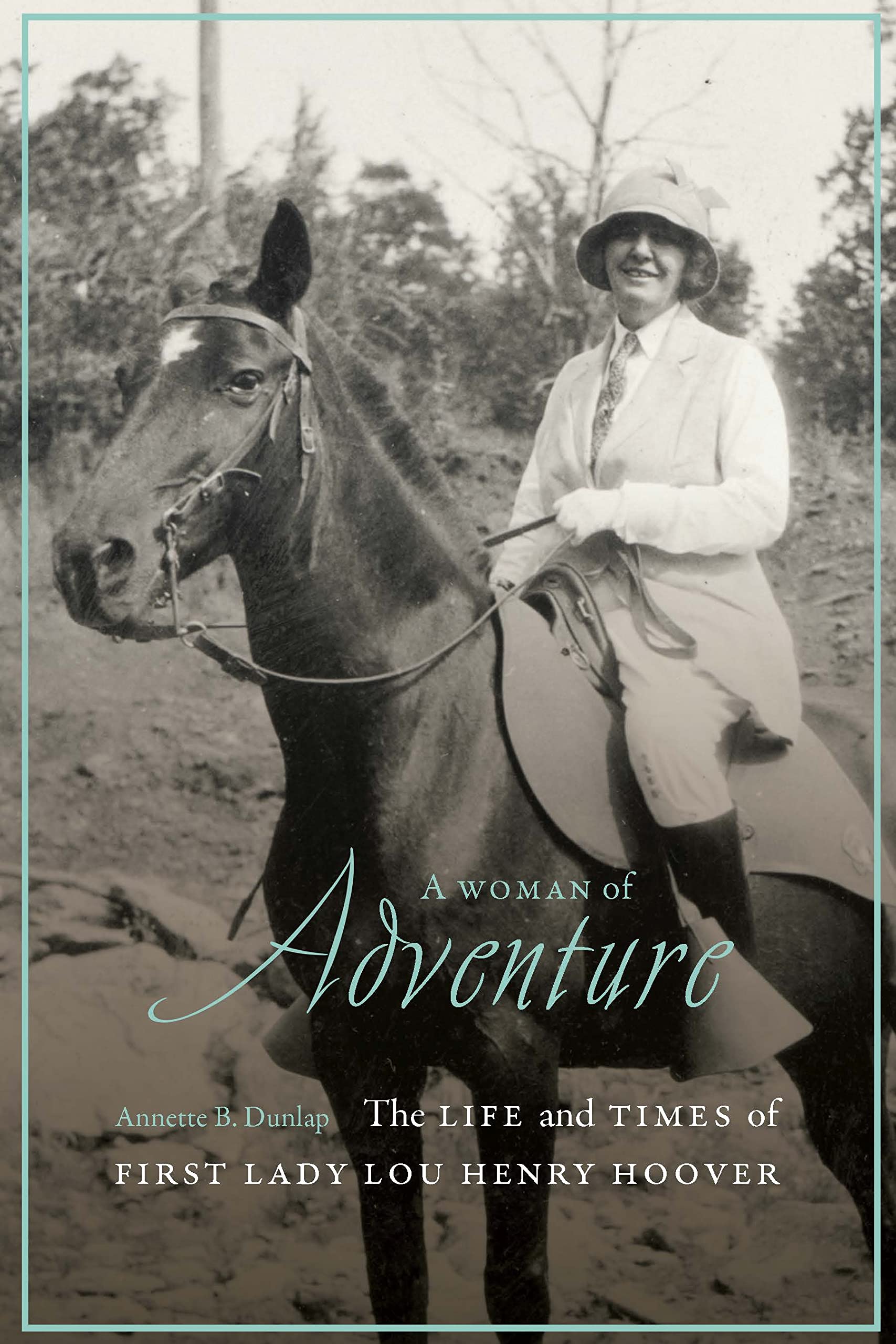A Woman of Adventure by Annette B. Dunlap
Once upon a time, most First Ladies were depicted as one-dimensional figures: perfect matches for their husbands’ ambitions, dedicated to the president’s success and wellbeing. In the course of the twentieth century, however, the media persuaded the public to believe in the duality of the First Lady. On one hand, she is a sociable, devoted wife and mother; on the other hand, she is politically shrewd and accomplished in her own right.
Tradition also would have us believe that First Lady is a happy woman. By now, of course, we know the truth. The president’s wife can smile radiantly while greeting heads of state and christening battleships, even if deep inside she feels angry or unfulfilled. This was certainly the case with Lou Henry Hoover, wife of one-term President Herbert Hoover, as she is portrayed in A Woman of Adventure, the Life and Times of First Lady Lou Henry Hoover by Annette B. Dunlap. It is the first scholarly biography of Hoover in almost 20 years and the second time that Dunlap, a journalist and historian, has explored the fertile ground of First Ladies’ lives.
Indeed, it is a surprise to learn that Lou Hoover increasingly harbored resentment toward “Bert” in the course of their 45-year marriage. During her husband’s early-twentieth century career as a mining executive, Lou accompanied him all over the world. Their partnership appeared to be a quintessential meeting of the minds, for they shared a love of science, history, innovation, and outdoor adventures. Yet during World War I [1914-1918], their marriage began to crumble and never recovered.
ANNETTE DUNLAP HAS GONE BEYOND BIOGRAPHICAL CONVENTIONS
Lou Henry and Herbert Hoover both experienced peripatetic childhoods in the Midwest and West Coast, as well as Quaker upbringings. Born a few months apart in 1874, neither reared in affluence, they were both determined to attain college degrees. Bert was among the first students to enter the fledgling, tuition-free Stanford University in 1891 and Lou, after teaching and working as a bank clerk, entered Stanford in 1894. Both found science riveting. Evidently their romance was helped along by geology professor John C. Branner, who mentored them with enthusiasm and affection. Although Bert graduated a few years before Lou, the couple’s relationship flourished. In 1899, when Bert was hired to be an advisor to the Kaiping Mining Company in China, he cabled a proposal to Lou: “Going to China via San Francisco. Will you go with me?” She replied: “Yes.”
On the threshold of a new century, the couple were married at Lou’s parents’ home in Monterey, California. Almost immediately they boarded a train to San Francisco and set sail for Shanghai. They arrived in the midst of the Boxer Rebellion, a violent peasant insurrection that targeted foreign missionaries, investors, and officials who controlled the Chinese economy and influenced Chinese culture. The Boxers terrorized Westerners although American, Russian, German, and Japanese troops quashed the rebellion.
Lou was happy when Bert became manager of overseas operations for a mining and engineering firm based in London. There, he began to build his fortune as a minerals expert, acquiring properties worldwide. Toting their firstborn son, the Hoovers traveled through Australia and southeast Asia. By 1914, the start of World War I, the Hoovers were a family of four and Lou had become a leader of the Society of American Women in London. Like her husband, she enjoyed and had a talent for organizing.
However, as wartime atrocities mounted, she and the children sailed home to the United States while Bert became deeply involved in the coordination of humanitarian aid for refugees. He helped establish the Commission for Relief in Belgium and subsequently demanded that Lou leave her “two dear little boys,” as she described them, and return to London to assist with entertaining and recruitment. She stayed a year, brimming with fear and despair and fuming, Dunlap suggests, about her husband’s inability to express his appreciation of her work.
THE FIRST SCHOLARLY BIOGRAPHY OF HOOVER IN 20 YEARS
After the United States entered the war in 1917, Bert returned home—to Washington, D.C., not California where his family lived. President Wilson had asked the rising star to lead the U.S. Food Administration agency, which managed food for American consumption and distributed it abroad to combat famine. During these years, Lou began to experience feelings of isolation, exacerbated by Bert’s poor communication and emotive skills, which he seems to have reserved for her.
Eventually, Lou and the boys made their way to D.C., where she held a senior position in the Red Cross during the war, helped found the Women’s City Club of Washington, and made a lifetime commitment to the Girl Scouts. Like Eleanor Roosevelt, who pursued her passion for social justice outside of FDR’s purview, Lou developed social and philanthropic networks around her own interests. The challenges enabled her to weather “the on-again, off-again intimacy of her marriage,” Dunlap writes.
Through the 1920s, Bert continued his involvement in public affairs as Secretary of Commerce under Presidents Harding and Coolidge. In 1927, he gained renown for his greatest achievement, coordinating disaster aid after a devastating Mississippi River flood. Riding high, Bert went on to win the presidency in 1928 after running a brutal anti-Catholic campaign against the Democratic nominee, New York Governor Alfred E. Smith.
Ultimately, the great adventures of Lou Hoover’s life occurred when she was a young woman traveling and learning about the world, not yet resigned to Bert’s inhibitions. Annette Dunlap has gone beyond biographical conventions by giving us not just the woman behind the man but the whole woman’s inner life.





